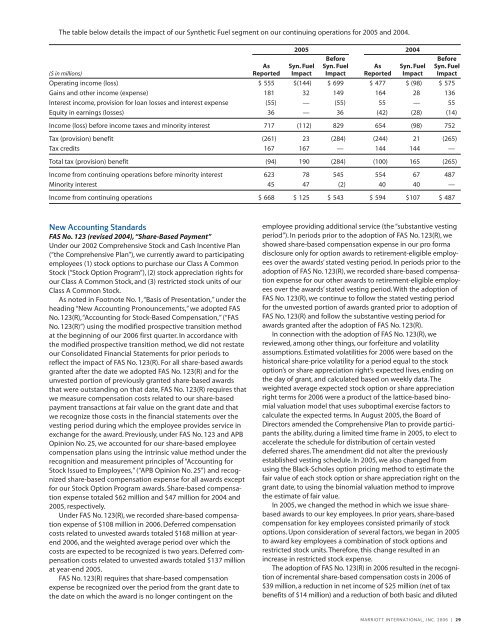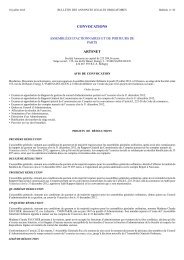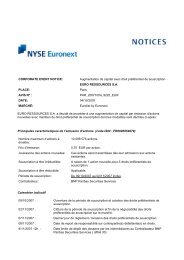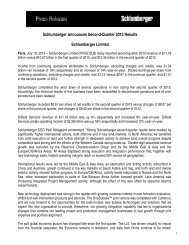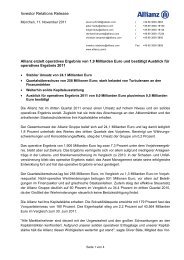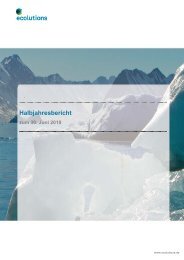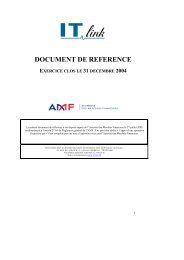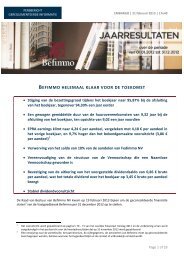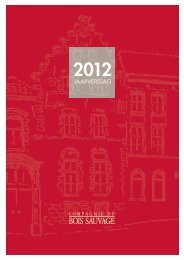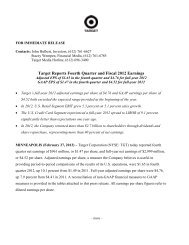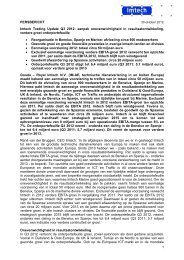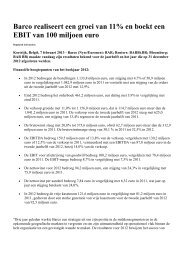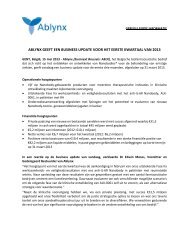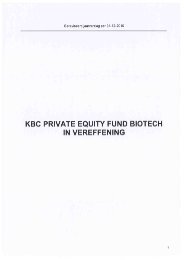2006 Annual Report
2006 Annual Report
2006 Annual Report
You also want an ePaper? Increase the reach of your titles
YUMPU automatically turns print PDFs into web optimized ePapers that Google loves.
The table below details the impact of our Synthetic Fuel segment on our continuing operations for 2005 and 2004.<br />
2005 2004<br />
Before Before<br />
As Syn. Fuel Syn. Fuel As Syn. Fuel Syn. Fuel<br />
($ in millions) <strong>Report</strong>ed Impact Impact <strong>Report</strong>ed Impact Impact<br />
Operating income (loss) $ 555 $(144) $ 699 $ 477 $ (98) $ 575<br />
Gains and other income (expense) 181 32 149 164 28 136<br />
Interest income, provision for loan losses and interest expense (55) — (55) 55 — 55<br />
Equity in earnings (losses) 36 — 36 (42) (28) (14)<br />
Income (loss) before income taxes and minority interest 717 (112) 829 654 (98) 752<br />
Tax (provision) benefit (261) 23 (284) (244) 21 (265)<br />
Tax credits 167 167 — 144 144 —<br />
Total tax (provision) benefit (94) 190 (284) (100) 165 (265)<br />
Income from continuing operations before minority interest 623 78 545 554 67 487<br />
Minority interest 45 47 (2) 40 40 —<br />
Income from continuing operations $ 668 $ 125 $ 543 $ 594 $107 $ 487<br />
New Accounting Standards<br />
FAS No. 123 (revised 2004), “Share-Based Payment”<br />
Under our 2002 Comprehensive Stock and Cash Incentive Plan<br />
(“the Comprehensive Plan”), we currently award to participating<br />
employees (1) stock options to purchase our Class A Common<br />
Stock (“Stock Option Program”), (2) stock appreciation rights for<br />
our Class A Common Stock, and (3) restricted stock units of our<br />
Class A Common Stock.<br />
As noted in Footnote No. 1,“Basis of Presentation,” under the<br />
heading “New Accounting Pronouncements,” we adopted FAS<br />
No. 123(R),“Accounting for Stock-Based Compensation,” (“FAS<br />
No. 123(R)”) using the modified prospective transition method<br />
at the beginning of our <strong>2006</strong> first quarter. In accordance with<br />
the modified prospective transition method, we did not restate<br />
our Consolidated Financial Statements for prior periods to<br />
reflect the impact of FAS No. 123(R). For all share-based awards<br />
granted after the date we adopted FAS No. 123(R) and for the<br />
unvested portion of previously granted share-based awards<br />
that were outstanding on that date, FAS No. 123(R) requires that<br />
we measure compensation costs related to our share-based<br />
payment transactions at fair value on the grant date and that<br />
we recognize those costs in the financial statements over the<br />
vesting period during which the employee provides service in<br />
exchange for the award. Previously, under FAS No. 123 and APB<br />
Opinion No. 25, we accounted for our share-based employee<br />
compensation plans using the intrinsic value method under the<br />
recognition and measurement principles of “Accounting for<br />
Stock Issued to Employees,” (“APB Opinion No. 25”) and recognized<br />
share-based compensation expense for all awards except<br />
for our Stock Option Program awards. Share-based compensation<br />
expense totaled $62 million and $47 million for 2004 and<br />
2005, respectively.<br />
Under FAS No. 123(R), we recorded share-based compensation<br />
expense of $108 million in <strong>2006</strong>. Deferred compensation<br />
costs related to unvested awards totaled $168 million at yearend<br />
<strong>2006</strong>, and the weighted average period over which the<br />
costs are expected to be recognized is two years. Deferred compensation<br />
costs related to unvested awards totaled $137 million<br />
at year-end 2005.<br />
FAS No. 123(R) requires that share-based compensation<br />
expense be recognized over the period from the grant date to<br />
the date on which the award is no longer contingent on the<br />
employee providing additional service (the “substantive vesting<br />
period”). In periods prior to the adoption of FAS No. 123(R), we<br />
showed share-based compensation expense in our pro forma<br />
disclosure only for option awards to retirement-eligible employees<br />
over the awards’ stated vesting period. In periods prior to the<br />
adoption of FAS No. 123(R), we recorded share-based compensation<br />
expense for our other awards to retirement-eligible employees<br />
over the awards’ stated vesting period. With the adoption of<br />
FAS No. 123(R), we continue to follow the stated vesting period<br />
for the unvested portion of awards granted prior to adoption of<br />
FAS No. 123(R) and follow the substantive vesting period for<br />
awards granted after the adoption of FAS No. 123(R).<br />
In connection with the adoption of FAS No. 123(R), we<br />
reviewed, among other things, our forfeiture and volatility<br />
assumptions. Estimated volatilities for <strong>2006</strong> were based on the<br />
historical share-price volatility for a period equal to the stock<br />
option’s or share appreciation right’s expected lives, ending on<br />
the day of grant, and calculated based on weekly data. The<br />
weighted average expected stock option or share appreciation<br />
right terms for <strong>2006</strong> were a product of the lattice-based binomial<br />
valuation model that uses suboptimal exercise factors to<br />
calculate the expected terms. In August 2005, the Board of<br />
Directors amended the Comprehensive Plan to provide participants<br />
the ability, during a limited time frame in 2005, to elect to<br />
accelerate the schedule for distribution of certain vested<br />
deferred shares. The amendment did not alter the previously<br />
established vesting schedule. In 2005, we also changed from<br />
using the Black-Scholes option pricing method to estimate the<br />
fair value of each stock option or share appreciation right on the<br />
grant date, to using the binomial valuation method to improve<br />
the estimate of fair value.<br />
In 2005, we changed the method in which we issue sharebased<br />
awards to our key employees. In prior years, share-based<br />
compensation for key employees consisted primarily of stock<br />
options. Upon consideration of several factors, we began in 2005<br />
to award key employees a combination of stock options and<br />
restricted stock units. Therefore, this change resulted in an<br />
increase in restricted stock expense.<br />
The adoption of FAS No. 123(R) in <strong>2006</strong> resulted in the recognition<br />
of incremental share-based compensation costs in <strong>2006</strong> of<br />
$39 million, a reduction in net income of $25 million (net of tax<br />
benefits of $14 million) and a reduction of both basic and diluted<br />
MARRIOTT INTERNATIONAL, INC. <strong>2006</strong> | 29


